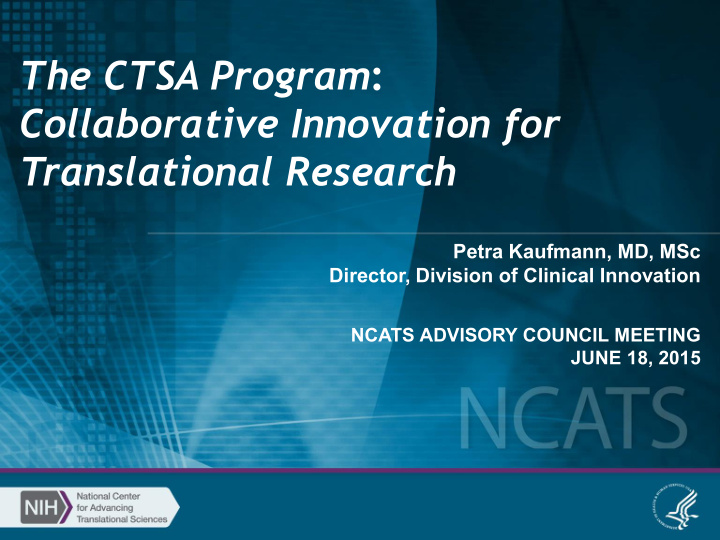



The CTSA Program : Collaborative Innovation for Translational Research Petra Kaufmann, MD, MSc Director, Division of Clinical Innovation NCATS ADVISORY COUNCIL MEETING JUNE 18, 2015
Transforming the CTSA Program Common Metrics Promoting Collaboration Strengthening Network Capacity Image Source: http://www.ifacile.com/2012/04/08/how-good-are-your-meetings/ 2
Common Metrics Transforming how we measure impact and manage strategically 3
Collaborative Approach to Metrics Initiative Guiding Principles adopted by the CTSA Steering Committee • Useful Must be useful to – and used by – the CTSA Principal Investigators and NCATS staff for the strategic management of the CTSA Program • Focus on Impact Will help to focus strategic management on maximizing the impact of the CTSA Program • Collaborative Leadership A systematic, transparent framework that fosters collaboration and shared accountability for maximizing the impact of the CTSA Program 4
Collaborative Leadership Guiding Principles adopted by the CTSA Steering Committee • PI Leadership CTSA Steering Committee, in partnership with NCATS, is leading the Common Metrics initiative Four Working Groups; PIs with active leadership roles • Building on Prior Work Building on prior work on metrics and evaluation Engaging the evaluation community • Intended use of Metrics If using metrics in assessing performance, always assess the context – story behind the curve Peer review process and NIH criteria are used for funding decisions 5
Case Study: Workforce Development What is the How are we doing What services desired impact Who are our at achieving that and resources of those services customers? desired impact? do we provide and resources on to those those “customers”? “customers”? % of scholars Courses, achieving Scholars Sustainable Training, careers in careers in Mentoring, translational translational etc… science science 6
Case Study: Workforce Development Potential Metric: % Common of scholars How are Measure achieving we doing? (the “Curve”) sustainable careers in translational science Why? The story behind the curve Who? Partners with a role to play in turning the curve Propose Action Plan to do? 7
Metrics: In Summary • Collaborative leadership • Metrics are intended to be used in context • Understand the story behind the curve • Identify partners who may have role to play in turning the curve • Brainstorming/Innovation/Joint-problem solving: Exploring and generating options for strategies that will turn the curve • Now working with PIs to develop metrics 8
COLLABORATIONS 9
CTSA Communications Structure • Domain Task Forces aligned with strategic goals • NIH, FDA and community members • Organizationally guided by the Steering Committee • Working Groups already launched Integration Workforce Collaboration Methods/ Informatics Across the Processes Development Engagement Lifespan 10
Fostering Collaborative Innovations in the CTSA network PAR-15-172 and PAR-15-173 • Address translational science roadblocks across the entire process • Encourage teams from multiple CTSA hubs to work together • Demonstrate utility across sites and disseminate approaches • New methods that can be applied to different disease areas 11
STRENGTHENING NETWORK CAPACITY 12
Innovation for Multi-site Studies: Participant Recruitment RFA TR 15-004 – CTSA Network Recruitment Innovation Centers (RICs) The problem: Slow recruitment delays most NIH-funded trials The approach: Build national recruitment capacity using data from the Electronic Health Record (EHR) to find potential trial participants who meet entry criteria NIH Partner : NLM Study planning phase Study implementation phase Privacy and IRB compliant Data-driven site selection recruitment plan Funded expert staff to Feasibility analysis help with implementation 13
Innovation for Multi-site Studies: Streamlining Processes RFA-TR-15-002 - CTSA Network Trial Innovation Centers (TICs) The problem: Study start-up takes too long The approach: Streamline, standardize and centralize processes NIH Partner: NIA Innovations in multi-site Single IRB study implementation Streamlined budgeting and contracting 14
Take-Home Messages • The current pace of translational science cannot address the opportunities. • 21 st c. needs cannot be solved with 20 th c. tools. • The CTSA program has begun to transform itself and its programs to meet these opportunities for the benefit of patients through: o Common Metrics – disciplined focus on impact o Collaborations – innovative discussions and projects o Strengthening Network Capacity – enabling multi-site studies 15
DISCUSSION 16
Recommend
More recommend